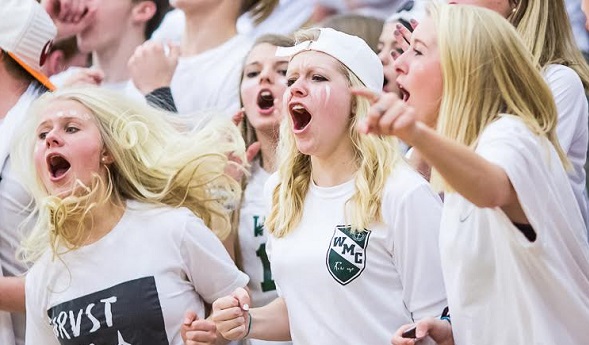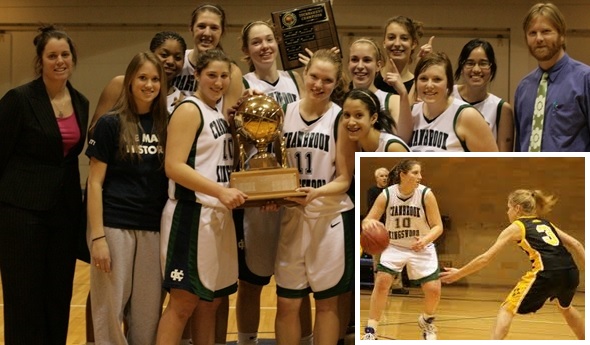
'Green Machine' Gears Up for BOTF V
January 26, 2016
By Geoff Kimmerly
Second Half editor
MUSKEGON – Lots of cheering. Lots of smiles. Everyone in beach gear and standing for a girls basketball game – flippers and all.
 The first revving of Western Michigan Christian’s “Green Machine” this winter won’t soon be forgotten by leaders charged this fall with organizing the few hundred students who now regularly fill a corner of the Warriors’ gym to cheer on their classmates.
The first revving of Western Michigan Christian’s “Green Machine” this winter won’t soon be forgotten by leaders charged this fall with organizing the few hundred students who now regularly fill a corner of the Warriors’ gym to cheer on their classmates.
“It was like, ‘Whoa,’” senior Christopher Visser remembered of that first game together. Freshman Tyler Somers left with an impression that “we can do this.”
“It gave us a lot of confidence,” senior Lily Vander Molen said during Saturday’s Battle of the Fans finalists visit. “Like wow, this is our first try. Look at the great response we’ve gotten. It made me really proud of our school.”
The first four years of Battle of the Fans have uncovered common strategies for nurturing a strong student cheering section. Still, there isn’t a book explaining how to get one started.
WMC’s “mechanics” came up with a blueprint that over a few months has organized an already-enthusiastic student body of nearly 300 and made it a model for student sections statewide.
Western Michigan Christian was the second stop on this year’s BOTF finalists tour, which began with a trip to Yale on Jan. 15 and will continue with visits to Traverse City West, Munising and Charlotte over the next three weeks leading up to the naming of this year’s champion Feb. 19. The public may vote for its favorite on the MHSAA’s Facebook, Twitter and Instagram sites beginning Feb. 16, with the MHSAA Student Advisory Council taking that vote into consideration when selecting the champion after that vote has concluded.
Here’s how the Green Machine joined the party:
The scene was set for success with a student body that admittedly feels bonded, both by its small size and shared faith. Students at least recognize the rest of their classmates and meet for all-school chapel services weekly – and like most schools with an organized student section, attended games together in the past but en masse only for the big ones.
Athletic director Josh Glerum got the ball rolling at first this fall, showing senior Nathan Landheer the video from last year’s visit to eventual Battle of the Fans champion Dowagiac. Still, the small group of leaders who attended the MHSAA’s Sportsmanship Summit on Nov. 16 in Kalamazoo didn’t really understand what they were getting into even as they were making the trip.
 The Summit’s message of positive sportsmanship – and emphasis on Battle of the Fans – sunk in quickly.
The Summit’s message of positive sportsmanship – and emphasis on Battle of the Fans – sunk in quickly.
“We've always had a really cool student-based student section, just a really cool environment. We've always had this really cool spirit,” junior Kaitlyn Van Hekken said. “Everyone wants to come out and cheer people on. After (the Summit), we were like, this is something that we can do. Let's expand on this, because we already have all the people for it.”
The three leaders came back and started to spread the message. They first met as “mechanics” – Glerum selected the representatives, including Landheer, Vander Molen, Visser, senior Maddy Heffron, Van Hekken and junior Dorie Bekins, sophomore Natalie Van Houwelingen and freshmen Somers and Sarah Moorhead – the Tuesday after the Summit and began hatching the plan.
They would work to have big crowds for Friday night home games – WMC parties students would look forward to all week. And they would point toward Battle of the Fans as the drive for participation.
“I love getting crazy, and I'm also a really competitive person. So if you're going to put me in a competition where all I have to do is get crazier than the other people, I will win that competition,” Visser said.
“We just know this school is super close, together. So basically it was just like, hey, let's go get all of our friends and do this thing.”
Communication had to be a focus – first to tell classmates there would be a student section, then to explain how the section would work.
And it needed a name.
Using Twitter, Snapchat, Survey Monkey and old-fashioned e-mail, students cast votes – Warrior Nation and Gang Green also were candidates – and Green Machine came out as the big winner.
Mechanics decided the key would be big turnouts immediately for the opening games for both the girls (Dec. 1) and boys basketball (Dec. 8) teams. They started planning themes for those games and preparing a list of cheers. They came up with contests for best costume for theme nights and games for students to play during halftime.
The mechanics took all of it to the student body during a pep assembly where each mechanic dressed up for a different theme, explained Battle of the Fans, what they learned at the Summit and showed the Dowagiac video to the entire school.
“I don’t know if we knew how to do anything,” Van Hekken said. “We’re like, maybe a pep assembly would work. We had an idea. Let’s just try a pep assembly, see how it goes. The response was overwhelmingly good.”
 They circled that girls opener as a “Beach Night” and hoped for the best.
They circled that girls opener as a “Beach Night” and hoped for the best.
The best continues to get better.
For Saturday’s girls and boys games against Spring Lake, nearly 180 students filled one set of stands, with a sizable pep band filling the adjacent corner and a group of middle schoolers then packing half the baseline stands on the other side. WMC has four feeder middle schools, and mechanics have made sure to include those students to get them to not only participate this year, but take up the mission for years to come.
The cheers aren’t much different than what students have done in the past, but the intensity and participation are different, Landheer said. Students load into spirit buses for away games when available, rushing to the school office to reserve seats.
And the bond already present has grown tighter, with the Green Machine another way for a close-knit student community to feel even more inclusive.
“The coaches came up to me afterward (the first night) and said this is the best the girls have ever played; ‘Thank you for starting to lead the student the right way.’ That was my encouragement to keep going with these,” Landheer said.
“Even if you’re not involved in the sport of basketball, you can still come out on Friday nights and feel part of the team. We create a team on the court and a team in the stands, (and) we work together.”
PHOTOS: (Top) Western Michigan Christian students cheer on their boys basketball team Saturday night. (Middle) The Green Machine student section cheers for classmates during pregame introductions. (Below) Senior Christopher Visser waves the WMC flag to rev up the crowd. (Photos by Randy Riksen Photography.)

Cohen Champions Treatment, Technology
By
Geoff Kimmerly
MHSAA.com senior editor
March 10, 2014
By Geoff Kimmerly
Second Half editor
Abby Cohen was looking for a problem to solve.
Two years later, she’s potentially only one more year from helping relieve a medical dilemma faced by 25 million Americans.
And the most impressive part might be that she graduated from high school a mere five years ago and is 23 years old.
 Cohen, a 2009 MHSAA Scholar-Athlete Award winner as a senior at Bloomfield Hills Cranbrook-Kingswood, certainly could be called proactive, going back to her days as a volleyball, basketball and soccer standout for the Cranes. Less than a year after graduating from Washington University in St. Louis, Mo., she’s co-founder and co-CEO of Sparo Labs, which seeks to provide asthma sufferers with a proactive way of monitoring their symptoms and improving their treatments.
Cohen, a 2009 MHSAA Scholar-Athlete Award winner as a senior at Bloomfield Hills Cranbrook-Kingswood, certainly could be called proactive, going back to her days as a volleyball, basketball and soccer standout for the Cranes. Less than a year after graduating from Washington University in St. Louis, Mo., she’s co-founder and co-CEO of Sparo Labs, which seeks to provide asthma sufferers with a proactive way of monitoring their symptoms and improving their treatments.
“Everyone has a different perspective on how to go about doing things,” Cohen said. “For me, growing up trying to improve in sports, I’d write down a list of things to do every day and actually do them, follow through. That aspect of always wanting to get better, and improve, is something that’s carried through to the rest of what we do at Sparo and in general how I approach things.”
 On March 22, the MHSAA and Farm Bureau Insurance will recognize a 25th class of Scholar-Athlete Award winners. In advance of the celebration, Second Half has caught up with some of the hundreds who have been recognized (see additional links at the bottom of this page).
On March 22, the MHSAA and Farm Bureau Insurance will recognize a 25th class of Scholar-Athlete Award winners. In advance of the celebration, Second Half has caught up with some of the hundreds who have been recognized (see additional links at the bottom of this page).
Cohen, who also served on the MHSAA Student Advisory Council from 2007-09, chose Washington based on its strong engineering problem and successful women’s basketball program. She studied bio-medical engineering and was a freshman on the Bears team that defeated Hope College for the Division III national championship in 2010.
But that first season was followed by a series of ankle injuries that required reconstructive surgery – and, effectively, ended her collegiate sports career. She still can play pick-up games, but four-hour daily practices and the other commitments of a varsity program would've been too much.
She missed basketball. But the end of her competitive career on the court, as it turned out, allowed more time to dive into a new pursuit – and, in her words, “work with another kind of team.”
“I’m a big believer in everything happens for a reason,” Cohen said. “It was disappointing having to have surgery to make everything feel better, for the long term, not just basketball. For me at that time, I didn't appreciate that with the extra time I could have, I could take the time to try new things, make the world a better place.”
Cohen planned at first to eventually become a physician. She shadowed a number of doctors, but decided that in the long run she could have a greater impact as an engineer designing products physicians could use.
In addition to her classwork, she helped form an extracurricular entrepreneurial group – and set out for an issue in need of repair. She and her now-business partner Andrew Brimer didn't realize how many Americans are affected by asthma, “that respiratory diseases are the only ones getting worse over time rather than getting better. That although technology is improving, why it’s not making a dent.”
They set out find out and make that dent themselves.
Through a series of interviews with patients, doctors, respiratory therapists and others in the field, Cohen and Brimer got an idea what could help – an affordable, easy-to-use device to allow patients to monitor on their own their symptoms so they can better manage them and the treatments to help. Cohen and Brimer designed a device that plugs into a smart phone and allows patients to blow into it like a whistle and register lung function readings – while also collecting data on medications, pollen counts, and other variables that affect lung function. Their device also should dent the health care costs that go with current testing, which generally requires an office visit.
Sparo will work over the next six months to improve its app interface and user experience, and then submit for Food and Drug Administration approval at the end of this year or the beginning of 2015 – with the hope it will then become available to patients later next spring.
Cohen is based in St. Louis, where she and Brimer have been able to work with three large local hospitals and within a nurturing entrepreneurial community. Brimer's brother owns a tech education company in New York which has provided additional support as she and Brimer discussed what was possible. “We were talking to patients and physicians, and it just seemed like the right thing to do,” Cohen said. “If we weren’t going to do this, who was?”
Cohen and Brimer have won 9 of 11 entrepreneurship grant competitions they've entered, netting more than $300,000 to get their lab rolling and allow them to hire two more engineers. Long-term, today’s work could just be the start of what Cohen hopes eventually will reach into developing countries as well.
She remains in touch with a number of teachers at Cranbrook-Kingswood – also, her mother Sheila Cohen teaches sixth-grade math at the school – and she spoke there at the end of 2013 as part of a TEDx event.
As she continues to build her team, Cohen is reminded of additional lessons she learned on the courts and soccer field – including a major one that will continue to pay as Sparo expands.
“Learning how to work on a team, with really different personalities, different people who all play different roles,” Cohen said. “That really came from sports – the ability to work with people and reach one common goal.”
Click to read the series' first installments:
- 25 Years Later, Scholar Athletes Shine On
- On Call as Doctor, Director, Mom
- "Mailloux Management" Goes Global
- Goorhouse Gives Back at Home
PHOTO: Abby Cohen (10) helps her teammates hoist a trophy while a player at Bloomfield Hills Cranbrook-Kingswood in 2009. (Photo courtesy of Cranbrook-Kingswood.)

